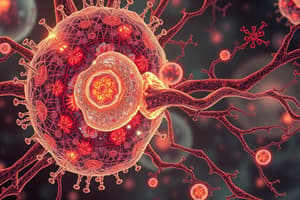Podcast
Questions and Answers
Which of the following is NOT a type of ligand?
Which of the following is NOT a type of ligand?
- Cell adhesion molecules
- Intracellular components (correct)
- Inhibitors
- Growth factors
What are the three domains that receptors on cell surfaces often consist of?
What are the three domains that receptors on cell surfaces often consist of?
- Intracellular, extracellular, and transmembrane (correct)
- Extracellular, intracellular, and nucleus
- Cytoplasm, intracellular, and extracellular
- Transmembrane, nucleus, and cytoplasm
What is the function of tyrosine kinase?
What is the function of tyrosine kinase?
- It limits receptor production
- It activates other proteins by phosphorylation (correct)
- It is a receptor
- It is a type of ligand
Flashcards are hidden until you start studying
Study Notes
- Ligands deliver signals for normal cell growth.
- Ligands can be growth factors, inhibitors, extracellular matrix components, or cell adhesion molecules.
- Receptors on cell surfaces transmit signals into the cell.
- Receptors often consist of three domains: extracellular ligand-binding, transmembrane, and intracellular.
- Tyrosine kinase is a receptor activated by ligand binding.
- Tyrosine kinase activates other proteins by phosphorylation.
- Normal cells respond to ligand binding by activating a cascade of signals.
- The nucleus is signaled to promote cell growth and division or stop growth.
- Cellular restraints on gene expression limit receptor production.
- Protein translation is also a factor in receptor production.
Studying That Suits You
Use AI to generate personalized quizzes and flashcards to suit your learning preferences.



